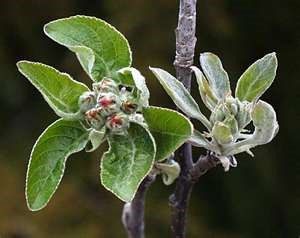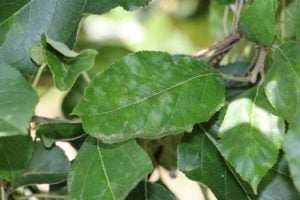Symptoms
- First symptoms seen on infected buds a few days after they open.
- Symptoms appear on expanding leaves as a small white-grey lesions that have powdery fungal growth (mycelium with conidia).
- The lower surface of leaves is usually initially colonized by the fungus.
- Infected flowers appear covered with the powdery growth.
- Severe infection during flowering can result in failure to set fruit, or russetting of fruit seen as a maze of fine lines often appearing as a solid patch.
- Especially in new varieties of apples, more Powdery Mildew is being seen and it tends not to russet as much as in older varieties.

Powdery mildew: healthy and infected apple fruit shoot at pink stage

Powdery mildew: Early symptoms on upper side of leaf
When to Monitor
- Monitor buds, flowers, leaves and shoots from green tip to petal fall to determine presence of primary infection, especially on susceptible varieties. Continue scouting until terminal shoot growth stops.
- Apple powdery mildew infection occurs from bud break to harvest, especially when trees are growing rapidly.
- Only new leaves are susceptible to infection and only for a few days after emergence.
- Fruit can be infected between pink and bloom.
- Leaf wetness is not necessary for infection.
- The disease develops most rapidly when humidity is high (>70%) and temperatures between 19-25ºC, under these conditions the fungus completes the life cycle very quickly.
- The period between tight cluster and petal fall is when the crop is at the greatest risk for infections.
- Factors that influence infection risk include amount of shoot growth, unprotected tissue and warm temperatures.
- Spraying before infection occurs is critical to managing powdery mildew.
Spraying
- In high-inoculum blocks or blocks with susceptible varieties, fungicide applications must target the disease between tight cluster and petal fall.
- Fungicides with the best efficacy for mildew should be selected.
- Include fungicides that are effective against mildew at least twice during the pink-petal fall period.
- Fungicide applications for mildew after second cover (petal fall) should be made if visible infections are found during scouting
Read the label of all fungicides prior to use and obey all resistance management guidelines and notes on compatibility with IPDM. This is critical in a high-pressure season for both scab and powdery mildew, especially in areas that have also had issues with Alternaria and Bitter rot in previous seasons because wet springs with periods of warm temperatures and high humidity favour those diseases as well.
Label restrictions for the number of applications per season are for the total number of applications regardless of target diseases.
Further Information
See Agriculture Victoria’s factsheet on Powdery Mildew of Apples
Article reviewed by Greg Lefoe (Agriculture Victoria)
